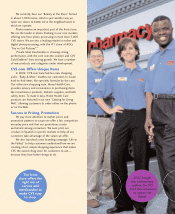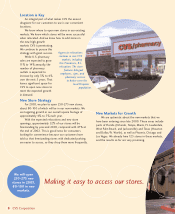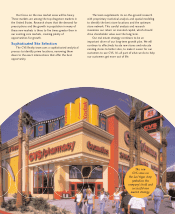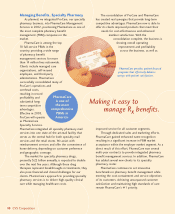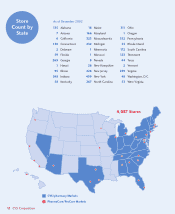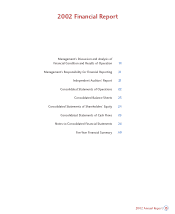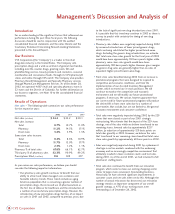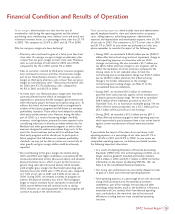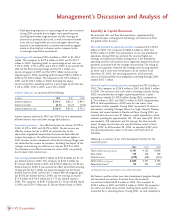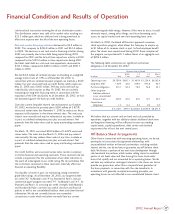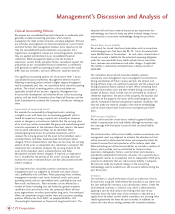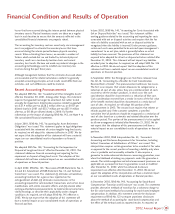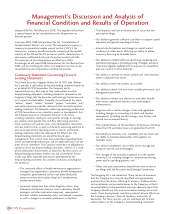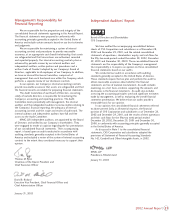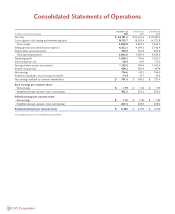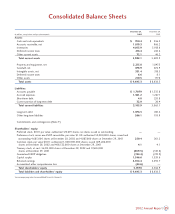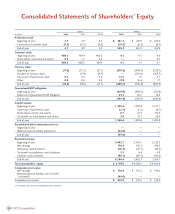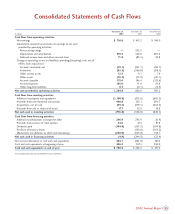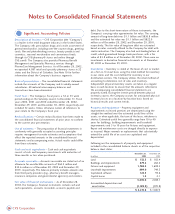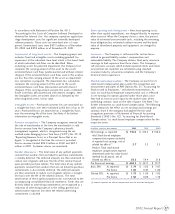CVS 2002 Annual Report Download - page 19
Download and view the complete annual report
Please find page 19 of the 2002 CVS annual report below. You can navigate through the pages in the report by either clicking on the pages listed below, or by using the keyword search tool below to find specific information within the annual report.
sale-leaseback transaction involving five of our distribution centers.
The distribution centers were sold at fair market value resulting in a
$35.5 million gain, which was deferred and is being amortized to
offset rent expense over the life of the new operating leases.
Net cash used in financing activities decreased to $4.9 million in
2002. This compares to $244.8 million in 2001 and $32.4 million
in 2000. The decrease in net cash used in financing activities during
2002 was primarily due to less debt being repaid during 2002
compared to 2001 and the lack of share repurchase activity in 2002
compared to the $129.0 million in share repurchases during 2001.
Net debt, total debt less cash and cash equivalents, decreased to
$412.7 million, compared to $836.3 million in 2001 and $810.7
million in 2000.
We had $4.8 million of commercial paper outstanding at a weighted
average interest rate of 1.9% as of December 28, 2002. In
connection with our commercial paper program, we maintain a $650
million, five year unsecured back-up credit facility, which expires on
May 21, 2006 and a $650 million, 364 day unsecured back-up
credit facility, which expires on May 19, 2003. We are currently
evaluating our long-term financing needs in connection with the
expiration of the 364-day facility. As of December 28, 2002, we had
not borrowed against the back-up credit facilities.
Given the current favorable interest rate environment, on October
30, 2002, we elected to privately place $300 million of 3.875%
unsecured senior notes due November 1, 2007, to reduce our future
exposure to fluctuations in short-term interest rates. The notes pay
interest semi-annually and may be redeemed at any time, in whole or
in part, at a defined redemption price plus accrued interest. Net
proceeds from the notes were used to repay outstanding commercial
paper.
On March 19, 2001, we issued $300 million of 5.625% unsecured
senior notes. The notes are due March 15, 2006 and pay interest
semi-annually. We may redeem these notes at any time, in whole or
in part, at a defined redemption price plus accrued interest. Net
proceeds from the notes were used to repay outstanding commercial
paper.
Our credit facilities and unsecured senior notes contain customary
restrictive financial and operating covenants. These covenants do not
include a requirement for the acceleration of our debt maturities in
the event of a downgrade in our credit rating. We do not believe that
the restrictions contained in these covenants materially affect our
financial or operating flexibility.
Our liquidity is based, in part, on maintaining strong investment-
grade debt ratings. As of December 28, 2002, our long-term debt
was rated “A2” by Moody’s and “A” by Standard & Poor’s, and our
commercial paper program was rated “P-1” by Moody’s and “A-1” by
Standard and Poor’s. In assessing our credit strength, both Moody’s
and Standard & Poor’s consider our capital structure and financial
policies as well as our consolidated balance sheet and other financial
information. We do not currently foresee any reasonable
circumstances under which we believe we would lose our current
investment-grade debt ratings. However, if this were to occur, it could
adversely impact, among other things, our future borrowing costs,
access to capital markets and new store operating lease costs.
On March 6, 2000, the Board of Directors approved a common
stock repurchase program, which allows the Company to acquire up
to $1 billion of its common stock, in part, to fund employee benefit
plans. No shares were repurchased during 2002. Since inception of
the program, we repurchased 8.1 million shares at an aggregate cost
of $292.2 million.
The following table summarizes our significant contractual
obligations as of December 28, 2002:
We believe that our current cash on hand and cash provided by
operations, together with our ability to obtain additional short-term
and long-term financing, will be sufficient to cover our working
capital needs, capital expenditures, debt service and dividend
requirements for at least the next several years.
Off-Balance Sheet Arrangements
Other than in connection with executing operating leases, we do not
participate in transactions that generate relationships with
unconsolidated entities or financial partnerships, including variable
interest entities, nor do we have or guarantee any off-balance sheet
debt. We finance a portion of our new store development through
sale-leaseback transactions, which involve selling stores to unrelated
parties at net book value and then leasing the stores back under
leases that qualify and are accounted for as operating leases. We do
not have any retained or contingent interests in the stores nor do we
provide any guarantees, other than a corporate level guarantee of
the lease payments, in connection with the sale-leasebacks. In
accordance with generally accepted accounting principles, our
operating leases are not reflected in our consolidated balance sheet.
Financial Condition and Results of Operation
Payments Due by Period
Within 1-3 3-5 After 5
In millions Total 1 Year Years Years Years
Operating Leases $9,709.8 $805.1 $1,487.4 $1,254.9 $6,162.4
Long-term debt 1,107.4 32.0 350.9 675.8 48.7
Purchase obligations 215.1 38.4 76.8 76.8 23.1
Other long-term
liabilities reflected
in our consolidated
balance sheet 203.3 42.0 87.5 37.1 36.7
Capital lease
obligations 1.5 0.2 0.4 0.4 0.5
$11,237.1 $917.7 $2,003.0 $2,045.0 $6,271.4
17
2002 Annual Report


